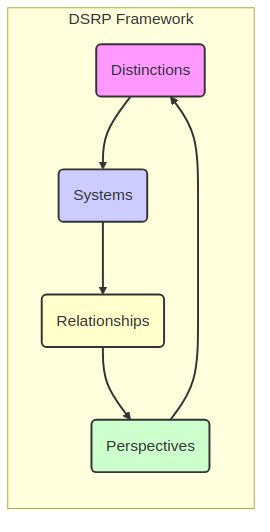DSRP Framework
Table of Contents
1. Overview
- D: Distinctions - Making distinctions between things and ideas; defining what something is and what it is not.
- S: Systems - Organizing things into systems; identifying parts and wholes, and relationships between them.
- R: Relationships - Identifying relationships between things and ideas; looking for influences and correlations.
- P: Perspectives - Recognizing different points of view; understanding how perspectives influence understanding.
The DSRP framework posits that these four elements (Distinctions, Systems, Relationships, Perspectives) are fundamental cognitive processes. They are interdependent and recursively applicable, meaning you can apply DSRP to DSRP itself. It's a systems thinking framework designed to enhance understanding and problem-solving by explicitly considering these four elements.
2. Systems Breakdown
1. Key Components of the DSRP Framework:
- Distinctions (D):
- Definition:* The act of drawing a boundary to differentiate one thing or idea from another. It involves identifying what something /is (identity) and what it is not (other).
- /Purpose:* Establishes clarity and specificity, enabling focused thinking and communication.
- /Example:* Distinguishing between "project goals" and "project tasks," where goals define the desired outcomes and tasks are the actions needed to achieve them.
- Systems (S):
- /Definition:* Organizing elements into a coherent whole, recognizing parts and the overall system they constitute.
- /Purpose:* Enables understanding of how individual components interact to produce emergent behavior and system-level outcomes.
- /Example:* Viewing a "marketing campaign" as a system comprising elements like target audience, messaging, channels, and feedback mechanisms.
- Relationships (R):
- /Definition:* Identifying connections, interactions, and influences between different elements within a system or between systems.
- /Purpose:* Reveals how changes in one area can affect others, highlighting dependencies and causal links.
- /Example:* Mapping the relationship between "customer satisfaction" and "product quality," where higher product quality leads to increased customer satisfaction.
- Perspectives (P):
- /Definition:* Recognizing that understanding is influenced by the point of view from which it is observed; acknowledging different viewpoints and their impact on interpretation.
- /Purpose:* Promotes empathy, reduces bias, and encourages a more comprehensive understanding by considering multiple angles.
- /Example:* Evaluating a "company policy" from the perspectives of employees, managers, and customers to understand its varied impacts and potential unintended consequences.
2. Analysis of Relationships and Interactions:
- Interdependence: DSRP elements are not isolated but deeply interconnected.
- /Distinctions & Systems:* Distinctions create the boundaries that define the elements within a system.
- /Systems & Relationships:* Systems thinking identifies the parts and then explores the relationships between them.
- /Relationships & Perspectives:* Relationships are interpreted differently based on the perspective taken.
- /Perspectives & Distinctions:* Perspectives influence what distinctions are made and considered relevant.
- Recursion: DSRP can be applied to itself, meaning each element can be further analyzed using DSRP. For example, you can apply DSRP to understand the "Systems" element itself, breaking it down into its distinctions, parts, relationships, and perspectives.
3. Simplification and Parts:
To simplify DSRP, consider it as a cycle of inquiry:
- Define: Start by making distinctions to define the scope of the problem or system.
- Organize: Arrange the distinguished elements into a system to see how they fit together.
- Connect: Identify the relationships between these elements to understand their interactions.
- Reflect: Consider different perspectives to refine your understanding and challenge assumptions.
4. Visual/Conceptual Model:
graph LR
subgraph DSRP Framework
D(Distinctions) --> S(Systems)
S --> R(Relationships)
R --> P(Perspectives)
P --> D
end
style D fill:#f9f,stroke:#333,stroke-width:2px
style S fill:#ccf,stroke:#333,stroke-width:2px
style R fill:#ffc,stroke:#333,stroke-width:2px
style P fill:#cfc,stroke:#333,stroke-width:2px
linkStyle 0,1,2,3 stroke:#333, stroke-width: 2px;

5. Actionable Insights and Recommendations:
- Problem-Solving: When faced with a complex problem, explicitly apply DSRP to break it down. Start by defining the key distinctions, then organize the elements into a system, identify relationships, and consider different perspectives.
- Decision-Making: Use DSRP to evaluate options by considering the system-wide impacts, potential relationships, and how different stakeholders might perceive the decision.
- Communication: Improve communication by explicitly addressing distinctions, systems, relationships, and perspectives to ensure a shared understanding.
- Learning: Enhance learning by actively applying DSRP to new information, organizing it into systems, identifying relationships, and considering different viewpoints.
- Strategic Planning: Utilize DSRP to develop comprehensive strategies by considering the interplay of various factors, potential impacts, and stakeholder perspectives.
By systematically applying DSRP, you can enhance your ability to understand, analyze, and navigate complex systems and challenges.